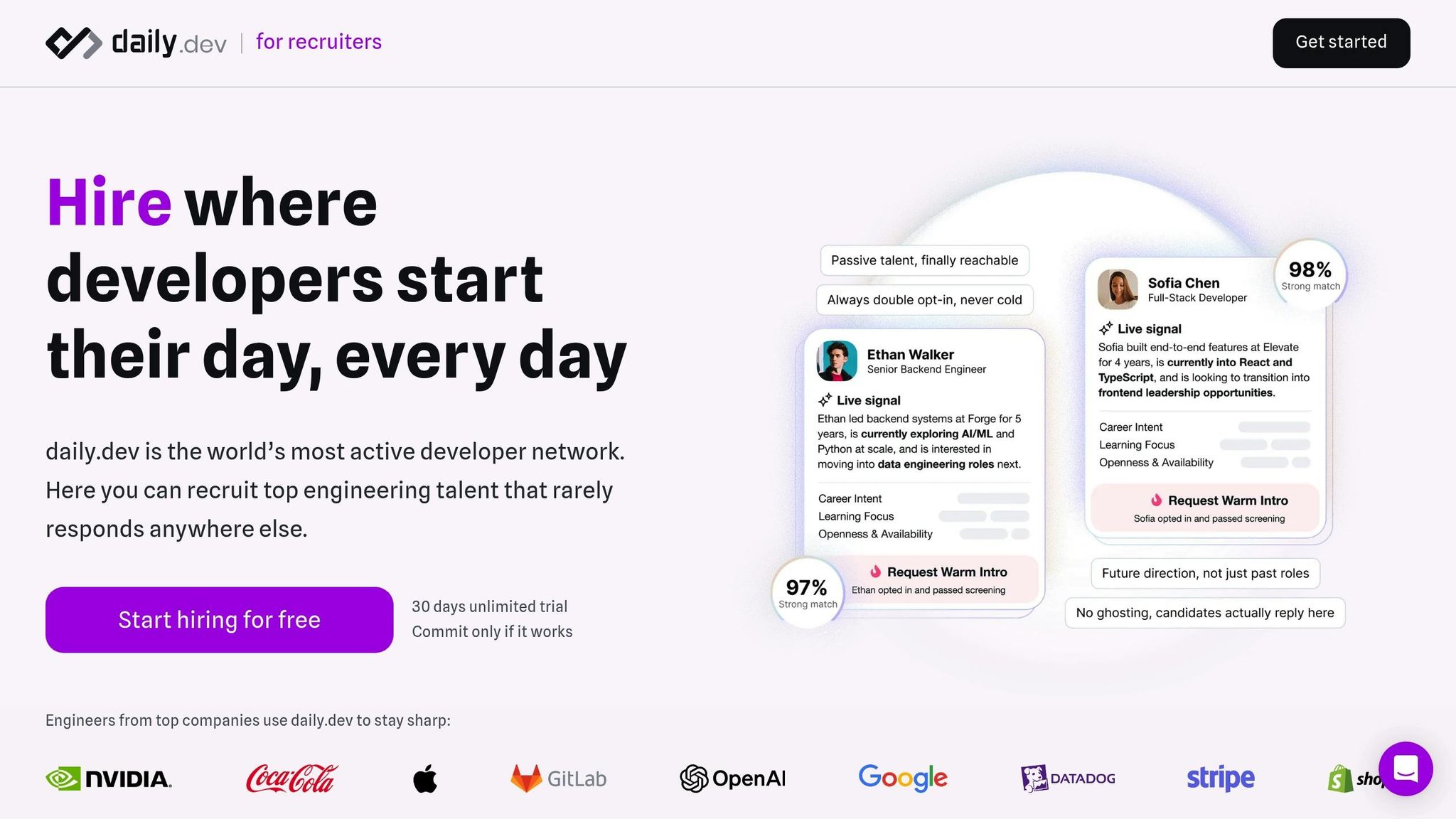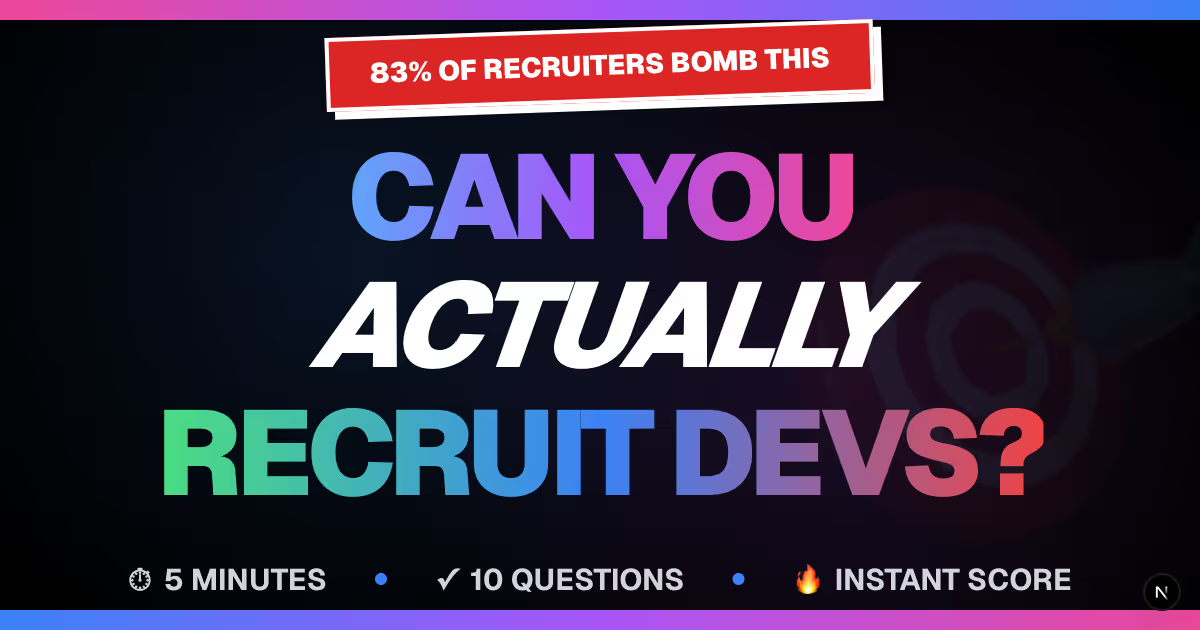


Learn how to fix common developer hiring issues by enhancing communication, simplifying applications, and targeting the right candidates.
Hiring developers can be challenging, but the key is understanding their preferences and building trust. Developers often avoid traditional recruiting methods due to issues like generic outreach, unclear job descriptions, ghosting, and irrelevant assessments. These problems discourage engagement and make it harder to attract top talent.
Here’s how to address these issues:
- Avoid generic outreach: Tailor messages to each candidate’s skills and interests.
- Simplify applications: Remove unnecessary steps and provide clear details upfront (e.g., salary, tech stack).
- Communicate consistently: Follow up with candidates and stick to timelines.
- Write better job descriptions: Be specific about responsibilities, technologies, and team dynamics.
- Use relevant assessments: Focus on tasks that match the job’s actual requirements.
To improve results, track metrics like response rates, time-to-hire, and candidate satisfaction. Platforms like daily.dev Recruiter can help by connecting you with developers already interested in your opportunities, ensuring higher engagement and more meaningful conversations.
When you respect developers’ time and expertise, you’ll build stronger relationships and attract the talent you need.
199. How Do I Find the Best Developer to Hire?
5 Developer Hiring Problems That Hurt Your Success
Hiring developers comes with its own set of challenges, and if you're not careful, these hurdles can slow down your recruitment efforts and drive away the talent you're trying to attract. To build a hiring process that respects developers' time and skills, it's crucial to identify and address the common pitfalls. From impersonal outreach to irrelevant assessments, these missteps can erode trust and make recruitment an uphill battle.
Generic Messages That Push Developers Away
Sending out mass, impersonal messages is a surefire way to alienate developers. When your outreach starts with vague greetings and offers "amazing opportunities" without any specifics, it screams a lack of effort. Worse, using outdated details or pitching roles that don’t align with a candidate’s skills or career goals only reinforces the idea that their expertise isn’t valued.
Overcomplicated Application Processes
Nothing turns candidates off faster than a cumbersome application process. Long forms, endless document uploads, and irrelevant screening questions create unnecessary friction. Developers, especially seasoned ones, are quick to walk away when faced with processes that bury critical details - like salary, team structure, or the nature of the work - behind layers of red tape.
Lack of Follow-Up That Hurts Your Brand
Reaching out to candidates and then going silent is a recipe for frustration. When recruiters fail to provide updates or feedback, it wastes candidates' time and leaves a bad impression. Word travels fast in professional networks, and these negative experiences can tarnish your company’s reputation among developers.
Job Posts That Miss the Mark
Job descriptions filled with buzzwords and vague phrases like "rockstar developer" or "fast-paced environment" do more harm than good. Without specifics - like the technologies involved, clear responsibilities, or team dynamics - these posts attract unqualified candidates and leave skilled developers guessing. This lack of clarity forces candidates to dig for basic information during initial conversations, which wastes time for everyone involved.
Assessments That Don’t Reflect Real Work
Generic coding challenges and whiteboard exercises often fail to showcase a developer's actual skill set. Experienced professionals see these as "trivia tests" that have little to do with solving real-world problems. Asking candidates to spend hours on irrelevant tasks not only undervalues their expertise but also discourages the very talent you’re hoping to hire.
How to Fix These Developer Hiring Problems
Making smart adjustments to your hiring approach can simplify the process and help you attract skilled developers. The trick lies in prioritizing what developers care about most - clarity, relevance, and respect for their expertise. Here’s how you can tackle common hiring challenges effectively.
Simplify Applications and Make Tests Relevant
Cut out unnecessary steps in your application process. Instead of asking candidates to fill out repetitive forms, use the data you already have. Revamp job descriptions into concise, developer-focused briefs that highlight critical details like the tech stack, team dynamics, growth paths, and specific challenges the role involves.
When it comes to technical assessments, focus on tasks that reflect the actual work candidates would be doing. For example, if the job involves API integrations, center the evaluation around those skills. If database optimization is key, make that the priority.
Tailor your screening process with custom questions that address specific role requirements - things that might not be obvious in a public job listing. Clear communication during this stage helps set the tone for a personalized and meaningful hiring experience.
Keep Candidates in the Loop
Establish clear timelines and stick to them. If you tell a candidate they’ll hear back in a week, make sure that happens - even if it’s just to request more time.
Be upfront about the role early in the process. Sharing a detailed overview before candidates invest too much time allows them to decide if the opportunity aligns with their goals.
Consider implementing a double opt-in system, where candidates review all the role details and actively choose to proceed. This ensures that every interaction is with someone genuinely interested, making conversations more productive and meaningful.
Craft Better Job Posts and Outreach Messages
Personalize your outreach to reflect each candidate’s unique experience and interests. Instead of generic emails, mention specific projects or skills that connect directly to the role.
Write clear, jargon-free job descriptions. Replace vague terms like "fast-paced environment" with concrete examples. For instance, explain whether your team is launching weekly features, scaling rapidly, or working in short sprint cycles.
Only share opportunities with developers who match the role’s qualifications and show genuine interest. This targeted approach saves time and avoids overwhelming candidates with irrelevant offers. Technology can help make this process more efficient while maintaining precision.
Leverage Tools Without Losing the Personal Touch
Use automation to handle scheduling and routine updates, but don’t let it replace genuine human interaction. Ensure that meaningful conversations come from real people who understand the role and can answer questions thoughtfully.
Platforms that connect roles with developer communities based on skills and career aspirations can significantly boost engagement. Early data shows that when developers receive truly tailored opportunities through trusted channels, response rates often exceed 85–90%.
The goal isn’t just to increase outreach - it’s to build trust through thoughtful, high-quality communication. Real, informed conversations with interested candidates will always outperform the scattershot approach of mass messaging. Focus on making every interaction count.
sbb-itb-d1e6221
How daily.dev Recruiter Fixes Developer Hiring Problems

Traditional hiring methods often fall short because they rely on impersonal and broad approaches like cold emails and mass outreach. daily.dev Recruiter takes a different path by embedding recruitment within a trusted and active developer community that has already seen over 1 billion developer sessions. Instead of treating hiring as a numbers game, this platform fosters trust and builds meaningful, context-driven interactions. Here’s how daily.dev Recruiter addresses the challenges of hiring developers.
Connect Only with Interested Developers
One of the biggest frustrations in traditional hiring is cold outreach. daily.dev Recruiter solves this by ensuring that every connection begins with a developer who has already reviewed and expressed interest in your job posting. Opportunities are showcased directly within the daily.dev platform, where developers are already active, consuming tech content, and staying updated on industry trends. Using proprietary data on developers' skills, interests, and career goals, the platform ensures job postings are matched with the right candidates. This approach results in impressive reply rates of 85–90%.
"Every role is presented within daily.dev where engaged developers explore opportunities. Our proprietary insights match jobs to their skills and passions." - daily.dev Recruiter
When a developer expresses interest, they are screened through up to three custom questions that you define. These questions validate specific requirements that might not be part of the public job description. This method taps into a pool of passive talent that is often unreachable through traditional methods - 90% of developers in the daily.dev network won’t reply elsewhere but are responsive on daily.dev.
Show Jobs to the Right Developers at the Right Time
Timing and relevance are key when it comes to hiring. daily.dev Recruiter ensures that job opportunities are presented to developers at the right moment by using real-time insights into their current interests and career stage. The platform transforms standard job descriptions into developer-friendly briefs, offering clear details about the role, tech stack, team culture, and growth opportunities. This ensures candidates have all the context they need before deciding to engage.
Rather than broadcasting job postings to a broad audience, daily.dev Recruiter targets opportunities based on developers’ demonstrated skills and interests. This eliminates irrelevant job spam and leads to more meaningful, pre-qualified conversations.
Build Trust Through Better Communication
Even with targeted outreach, trust is built through thoughtful communication. daily.dev Recruiter ensures a double opt-in process, meaning candidates engage only when they are genuinely interested. This creates more authentic and respectful interactions.
The platform also provides a comprehensive view of each candidate, including their work history, current interests, recent learning activities, and career aspirations. This enables more personalized and effective conversations between recruiters and developers.
"Every intro comes from a developer who reviewed your role and chose to engage - not someone you had to chase." - daily.dev Recruiter
Track Results and Keep Improving Your Hiring
Hiring isn’t a one-and-done process - it’s something that constantly evolves. The most effective hiring teams are always measuring their performance, gathering insights, and refining their approach. By tracking the right metrics and listening to feedback, you can fine-tune your process and stay ahead in the competitive world of developer hiring.
Monitor Key Metrics to Spot Issues
To improve, you need to know where things are going wrong. Start by keeping an eye on the numbers that matter most in developer hiring: response rates, time-to-hire, candidate satisfaction, and conversion rates.
- Response rates: Are candidates engaging with your outreach? If you’re not getting replies, it might mean your messaging isn’t hitting the mark or you’re targeting the wrong audience.
- Time-to-hire: Long hiring cycles can cost you top talent. If your process is dragging, it’s time to identify where things are slowing down.
- Candidate satisfaction: This tells you how developers feel about your hiring process. Low scores often point to problems like unclear job descriptions, overly long applications, or poor communication during interviews.
Sometimes, the numbers themselves can tell a story. For example, if response rates suddenly drop, it might signal changes in the job market or issues with your recent postings.
Collect Feedback From Candidates and Teams
Metrics give you the "what", but feedback reveals the "why." To truly understand what’s working (and what’s not), you need to talk to the people involved - both candidates and your hiring team.
Ask candidates directly about their experience. Were the job descriptions clear? Did the interview feel relevant to the role? How was the communication? Feedback from developers often highlights issues like irrelevant technical assessments or poor follow-up. For instance, Nimrod Kramer from daily.dev noted common complaints like "trivia interviews, ghosting, vague roles, fake jobs, and AI noise".
"What's broken about developer hiring?" - What we heard, what needs to change: We asked developers what's broken in hiring. Their answers: trivia interviews, ghosting, vague roles, fake jobs, and AI noise. Here's how to fix it (for real)." - Nimrod Kramer, daily.dev
Don’t just focus on candidates who complete the process. Those who drop out or decline offers can provide valuable insights. A quick survey asking why they stepped away can uncover areas that need improvement.
Your hiring team is another key source of feedback. Recruiters, hiring managers, and interviewers often notice patterns that metrics won’t show. For example, hiring managers might point out a mismatch between job requirements and the candidates applying, while interviewers can highlight where candidates tend to struggle. Creating open feedback loops between recruiters and hiring managers can also address misaligned expectations - a common issue that can derail the hiring process.
"The silent killer of recruiting is mismatched expectations with hiring managers." - Nimrod Kramer, daily.dev
Use Data to Drive Meaningful Changes
Once you’ve gathered your metrics and feedback, it’s time to act. Review your hiring data regularly - quarterly works well - and look for patterns. For example, if candidates frequently mention unclear job descriptions, invest time in rewriting them to better reflect technical requirements and your company’s values.
If you notice high drop-off rates during technical assessments, it might be time to rethink your approach. Replace generic coding tests with challenges that mirror the actual work your team does. This not only makes the process feel more relevant but also gives candidates a clearer picture of the role.
Test changes gradually and measure their impact. For instance, if you tweak your interview process, monitor how response rates and satisfaction scores evolve over the next few months. A/B testing can also be helpful - try two versions of a job description or outreach message to see which performs better.
Stay informed about trends in developer hiring. The tech industry moves fast, and what worked last year might not resonate with candidates today. Pay attention to shifts in priorities, like remote work preferences, competitive compensation, or opportunities for personal growth.
Finally, document what works. When you find strategies that deliver results, create playbooks so they can be applied across different roles and teams. At the same time, remain flexible - new insights might require you to adapt and refine your approach further.
Conclusion: Build a Hiring Process Developers Actually Like
Hiring developers doesn’t have to be a headache. The key lies in trust - earning it and keeping it. But rebuilding that trust means rethinking how you approach the process from the ground up.
The issues we’ve covered - generic outreach, overly complicated applications, poor communication, vague job descriptions, and irrelevant tests - often happen because developers are treated like any other candidate pool. The truth is, developers expect transparency, relevance, and respect. When your hiring process aligns with these values, the rest naturally follows.
So, how do you fix it? Start with the basics: craft job descriptions that are clear and specific, matching the actual role. Streamline your application process to make it as simple as possible. Swap out generic coding tests for challenges that reflect real-world projects. Keep candidates in the loop at every stage - even when there’s no immediate update. And, instead of interrupting developers with cold outreach, meet them where they already are.
That’s where daily.dev Recruiter comes in. This platform connects you with over 1,000,000 developers who are already active and engaged. Its double opt-in system ensures reply rates of 85–90%, making communication smoother from the start.
Quality is built into the platform. With 40% of daily.dev’s network made up of senior contributors and leaders, you’re tapping into a pool of passive talent - developers who aren’t actively job hunting but are open to the right opportunity when it’s presented with respect and clarity.
Hiring isn’t a one-and-done task; it’s a continuous process. The best teams consistently analyze their metrics, listen to feedback from candidates and hiring managers, and tweak their strategies as needed. What works today might not work tomorrow, especially as the market and developer expectations evolve.
When you create a hiring process that developers genuinely appreciate, you’re building more than just a pipeline - you’re fostering relationships with top talent. Positive experiences lead to referrals, even from candidates who don’t join your team. In a competitive market where developers have plenty of options, your reputation becomes your greatest asset.
The choice is simple: stick with outdated methods that frustrate everyone involved, or adopt a developer-first approach that builds trust, saves time, and delivers better results. Your next great hire is out there - reach them with a process they’ll respect and remember.
FAQs
How can I write job descriptions that attract the right developers?
To bring in the right developers, start with a job description that's clear, concise, and specific to the role. Focus on the skills, tools, and technologies that matter most for the position. At the same time, showcase what sets your company apart - whether it's exciting projects, opportunities for career growth, or a strong commitment to work-life balance. Skip the generic buzzwords and speak directly to what developers value.
With daily.dev Recruiter, your job posting becomes a developer-friendly summary that reaches only the candidates who truly fit. By matching roles to candidates based on skills, interests, and career goals, this tool helps you connect with the right talent faster, improving both response rates and hiring efficiency.
How can I keep developer candidates engaged during the hiring process?
To maintain the interest of developer candidates, it's essential to craft a hiring process that feels personal, transparent, and respectful of their time. Developers place a high value on clear communication, so make it a priority to provide timely updates and establish realistic expectations about each stage of the process.
Leveraging tools like daily.dev Recruiter can simplify this effort. This platform connects you with developers who are already active and engaged within their professional circles. With its warm, double opt-in introductions, you can ensure that candidates are genuinely interested in the role, building trust and minimizing the chances of losing their attention.
How does daily.dev Recruiter improve the process of hiring developers?
daily.dev Recruiter reshapes the way employers hire developers by linking them with pre-screened developers who are already part of the daily.dev community. Instead of resorting to cold outreach, it enables mutual, double opt-in connections, ensuring developers are genuinely open to exploring new opportunities.
This method, built on trust, minimizes ghosting, boosts response rates, and helps employers connect with motivated, skilled candidates more quickly. By engaging developers in the spaces where they already learn and network, daily.dev Recruiter streamlines the hiring process and makes it more meaningful for everyone involved.
Related Blog Posts








